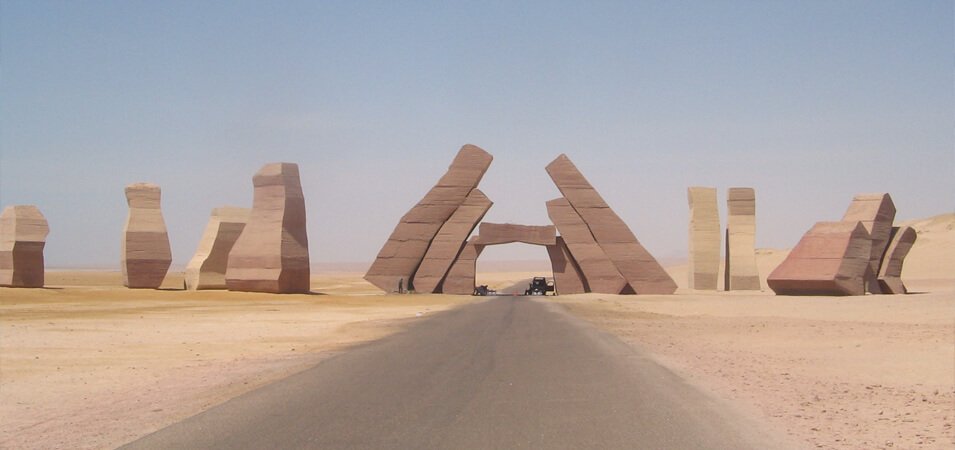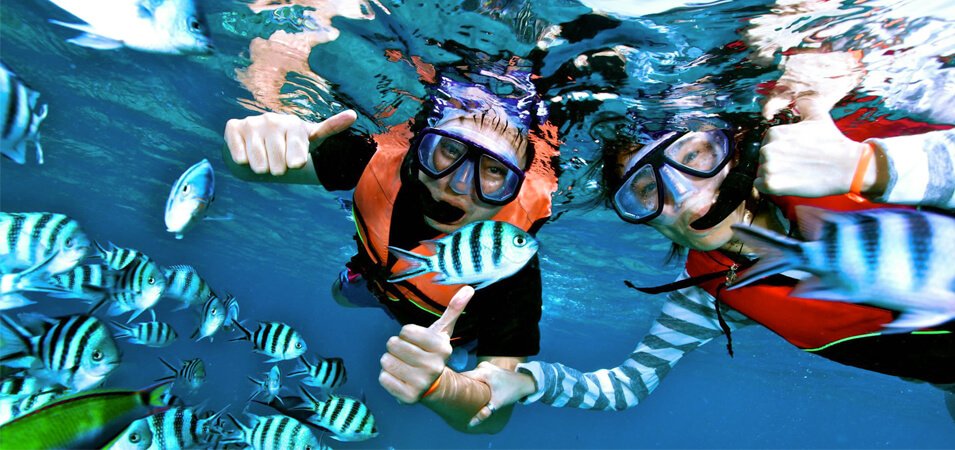Sunlight dances on the crystal-clear waters of the Red Sea, revealing a kaleidoscope of colors beneath the surface. Vibrant coral reefs erupt with life, hosting a dazzling array of fish darting in and out of intricate crevices. This is just the first glimpse of the magic that awaits at Ras Mohamed National Park, a jewel nestled on the southern tip of Egypt’s Sinai Peninsula.
Far more than just a haven for snorkelers and scuba divers, Ras Mohamed boasts a breathtaking diversity of ecosystems. Lush mangrove forests line the coast, providing a sanctuary for a myriad of bird species. Rugged desert mountains rise from the shoreline, offering a stark contrast to the underwater world. For those who venture deeper, dramatic underwater canyons and sheer walls create a diver’s paradise.
Beyond its natural beauty, Ras Mohamed holds a rich historical tapestry. The ancient walls of St. Paul’s Monastery, one of the oldest continuously functioning monasteries in the world, stand as a testament to the region’s long and fascinating past.
A Tapestry of Ecosystems: Unveiling Ras Mohamed’s Diverse Landscapes
Ras Mohamed National Park shatters the expectations of a typical beach getaway. Sure, the crystal-clear waters and vibrant coral reefs might be the initial lure, but scratch beneath the surface (literally and metaphorically), and you’ll discover a remarkable tapestry of ecosystems waiting to be explored. From the vibrant underwater world teeming with life to the arid desert vistas, Ras Mohamed offers a diversity of landscapes that caters to a variety of interests.
Underwater Paradise: A Diver’s Dream
Descend into the Red Sea at Ras Mohamed, and a kaleidoscope of colors explodes before your eyes. Coral reefs, sculpted by nature over millennia, erupt in a vibrant palette of oranges, pinks, purples, and yellows. These intricate structures teem with an astonishing variety of marine life. Schools of colorful fish flit through the coral formations, from the playful clownfish peeking out from anemones to the sleek surgeonfish gliding effortlessly. Keen-eyed observers may spot shy moray eels peeking out from their crevices, or trumpetfish hovering gracefully in the water column.
For the more adventurous explorer, dramatic underwater canyons and sheer walls create a diver’s paradise. Imagine navigating along a submerged cliff face, encountering schools of shimmering silverfish or a graceful manta ray gliding effortlessly through the blue. Experienced divers can explore the depths of Shark Observatory, a legendary dive site known for encounters with gray reef sharks and even the occasional hammerhead. Marine life thrives in these diverse underwater environments, creating a breathtaking spectacle for divers of all skill levels.

Mangrove Sanctuary: A Haven for Life
Stepping away from the water’s edge, you’ll encounter a fascinating contrast in the form of lush mangrove forests fringing the coastline. These unique ecosystems are not just beautiful; they play a vital role in the park’s health. Mangrove trees stand sentinel in shallow saltwater, their intricate root systems providing a nursery for juvenile fish and a breeding ground for invertebrates. The dense foliage offers a haven for a variety of birdlife, from the majestic gray heron stalking its prey to the brightly colored kingfisher perching on a branch.
The intricate web of life within the mangroves is a testament to the delicate balance of the ecosystem. The roots of the mangrove trees act as a natural filter, removing pollutants from the water before it reaches the delicate coral reefs. They also serve as a buffer against coastal erosion, protecting the shoreline and creating a safe haven for marine life during storms and strong currents. Exploring the mangrove forests, either by kayak or on designated walking trails, offers a glimpse into this vital ecosystem and the crucial role it plays in the park’s overall health.
Desert Majesty: A Stark Beauty
Turning your gaze inland, you’ll encounter a dramatic shift in scenery. Rugged desert mountains rise from the shoreline, their sun-baked peaks contrasting starkly with the vibrant coral reefs below. This arid landscape may seem desolate at first glance, but it possesses a unique beauty and resilience. For those seeking a different kind of adventure, hiking through the desert wadis reveals a surprising diversity of life adapted to the harsh environment. You might spot desert gazelles with their graceful movements or the elusive fennec fox with its oversized ears. Birdwatchers can look out for soaring eagles and desert larks flitting between rocky outcrops.
The silence of the desert, broken only by the wind whistling through canyons, offers a stark contrast to the teeming life underwater. However, beneath the surface, there’s a hidden connection. Desert rains and flash floods carry vital nutrients down the wadis, ultimately reaching the coral reefs and contributing to their growth and resilience. Understanding and appreciating the desert landscape is key to appreciating the delicate balance of the entire ecosystem within Ras Mohamed National Park.
From the vibrant coral reefs and lush mangroves to the arid beauty of the desert, Ras Mohamed National Park offers a unique blend of ecosystems. Each one plays a crucial role in maintaining the overall health of the park. Whether you’re a seasoned diver seeking underwater wonders, a nature enthusiast drawn to the tranquility of the mangroves, or an adventurer eager to explore the desert landscapes, Ras Mohamed has something to offer everyone.
A Glimpse into History: Unveiling Ras Mohamed’s Rich Tapestry
Ras Mohamed National Park isn’t just a haven for nature lovers; it’s a treasure trove for history lovers as well. Beneath the crystal-clear waters and vibrant coral reefs lies a rich tapestry woven with stories of ancient civilizations, religious devotion, and the whispers of lost empires. Here’s a glimpse into the historical wonders that await:
Enduring Faith: St. Paul’s Monastery
Explore St. Paul’s Monastery, one of the oldest continuously functioning monasteries in the world.
Witness the architectural blend of Byzantine and Coptic influences, reflecting the region’s unique history.
Experience the serenity of the monastery and learn about the enduring traditions of its monks.
Echoes of Trade Routes: A Crossroads of Civilizations
Uncover the strategic location of Ras Mohamed at the crossroads of ancient trade routes.
Imagine ships laden with treasures navigating the Red Sea, seeking safe harbor along the park’s shores.
Discover potential connections to empires like the Nabataeans and the Romans through historical evidence.
Whispers of Shipwrecks and Lost Treasures
Explore the stories behind shipwrecks scattered across the seabed, testaments to the perils of maritime navigation.
Uncover fragments of pottery, anchors, and other artifacts through archaeological investigations.
Dive into the world of underwater archaeology at popular dive sites like the SS Yolanda shipwreck.
Mysteries and Legends: Fueling the Imagination
Spark your curiosity with unsolved historical puzzles and legends surrounding the region.
Consider the potential connection of Ras Mohamed to the Lost City of Atlantis, fueled by geographical features and location.
Delve into the rich oral tradition of the Bedouin people and their stories of hidden treasures or forgotten cities.
Unearthing the Past: Ongoing Efforts
Learn about ongoing archaeological research that sheds light on the region’s fascinating past.
Discover how excavations uncover ancient settlements and artifacts, offering glimpses into the lives of past inhabitants.
Appreciate historical preservation efforts that safeguard the legacy of St. Paul’s Monastery and other sites.

A Classroom Without Walls: Learning from Ras Mohamed National Park
Ras Mohamed National Park isn’t just a playground for adventure; it’s a living classroom teeming with opportunities for students of all ages. Here, the vibrant tapestry of ecosystems unfolds as an open book, revealing the wonders of biodiversity and the delicate balance of nature.
A Symphony of Life: Exploring Biodiversity
Ras Mohamed boasts a remarkable diversity of ecosystems, each playing a crucial role in the park’s overall health. The coral reefs, with their kaleidoscope of colors and bustling marine life, form the cornerstone of this underwater world. These intricate structures provide a haven for a staggering variety of fish, from the shy clownfish hiding in anemones to the majestic manta ray gliding effortlessly through the water. However, the coral reefs are not isolated entities. They rely on the vital filtration provided by the lush mangrove forests that fringe the coastline. These tangled ecosystems serve as nurseries for juvenile fish and a breeding ground for invertebrates, creating a vital link between the land and the sea. Further inland, the stark beauty of the desert ecosystem shouldn’t be overlooked. While seemingly barren at first glance, this arid landscape provides habitat for a variety of adapted creatures like desert foxes and gazelles. By understanding the interconnectedness of these ecosystems, students gain a holistic perspective on the delicate balance of nature at play within Ras Mohamed National Park.
Protecting a Paradise: Marine Conservation in Action
The importance of marine conservation becomes strikingly clear when exploring Ras Mohamed. Climate change, overfishing, and pollution pose significant threats to the park’s delicate ecosystems. However, there is hope. Conservation initiatives are underway to safeguard this underwater paradise. Marine protected areas like Ras Mohamed play a crucial role in limiting fishing pressure and allowing fish populations to recover. Additionally, research and monitoring programs are conducted to assess the health of the coral reefs and identify threats. Students can learn about these initiatives and discover how seemingly small actions, like reducing plastic waste or choosing sustainable seafood, can contribute to a larger movement.
FAQs
What is Ras Mohamed National Park?
Ras Mohamed National Park is a protected area located at the southern tip of Egypt’s Sinai Peninsula, renowned for its stunning coral reefs, diverse ecosystems, and historical significance.
Why is Ras Mohamed famous for snorkeling and diving?
Ras Mohamed is famous for its vibrant coral reefs and diverse marine life, including colorful fish, moray eels, and even sharks. The park’s clear waters and dramatic underwater landscapes, such as canyons and walls, make it a diver’s paradise.
What types of ecosystems can be found in Ras Mohamed?
The park features a variety of ecosystems, including vibrant coral reefs, lush mangrove forests, and rugged desert landscapes. Each plays a crucial role in maintaining the park’s overall ecological balance.
Can I explore Ras Mohamed’s history while visiting?
Yes, Ras Mohamed has a rich historical background, including the ancient St. Paul’s Monastery and remnants of trade routes. Visitors can explore the park’s history both on land and underwater, with sites like the SS Yolanda shipwreck.
What wildlife can I expect to see in Ras Mohamed?
In addition to the rich marine life, visitors may spot desert gazelles, fennec foxes, various bird species, and the unique flora of the mangrove forests.
How do I visit Ras Mohamed National Park?
Ras Mohamed is accessible from Sharm El-Sheikh, where you can join guided tours or self-drive. Entrance fees apply, and the park offers various activities, including snorkeling, diving, and hiking.
Conclusion
Ras Mohamed National Park emerges as a multifaceted jewel, offering something for every visitor. Travelers can marvel at the vibrant underwater world teeming with life, or embark on thrilling adventures that range from snorkeling and diving to desert hikes. History buffs can delve into the rich tapestry of the past, exploring ancient sites like St. Paul’s Monastery and uncovering whispers of trade routes and lost civilizations. For students, the park transforms into a living laboratory, showcasing the importance of ecological balance and the ongoing efforts to conserve this irreplaceable marine environment.
Beyond the awe-inspiring beauty, responsible tourism is paramount. Simple actions, like using reef-safe sunscreen and avoiding touching coral, contribute significantly to the park’s preservation. Ras Mohamed is committed to sustainable tourism practices, ensuring visitors can enjoy its wonders for generations to come.
